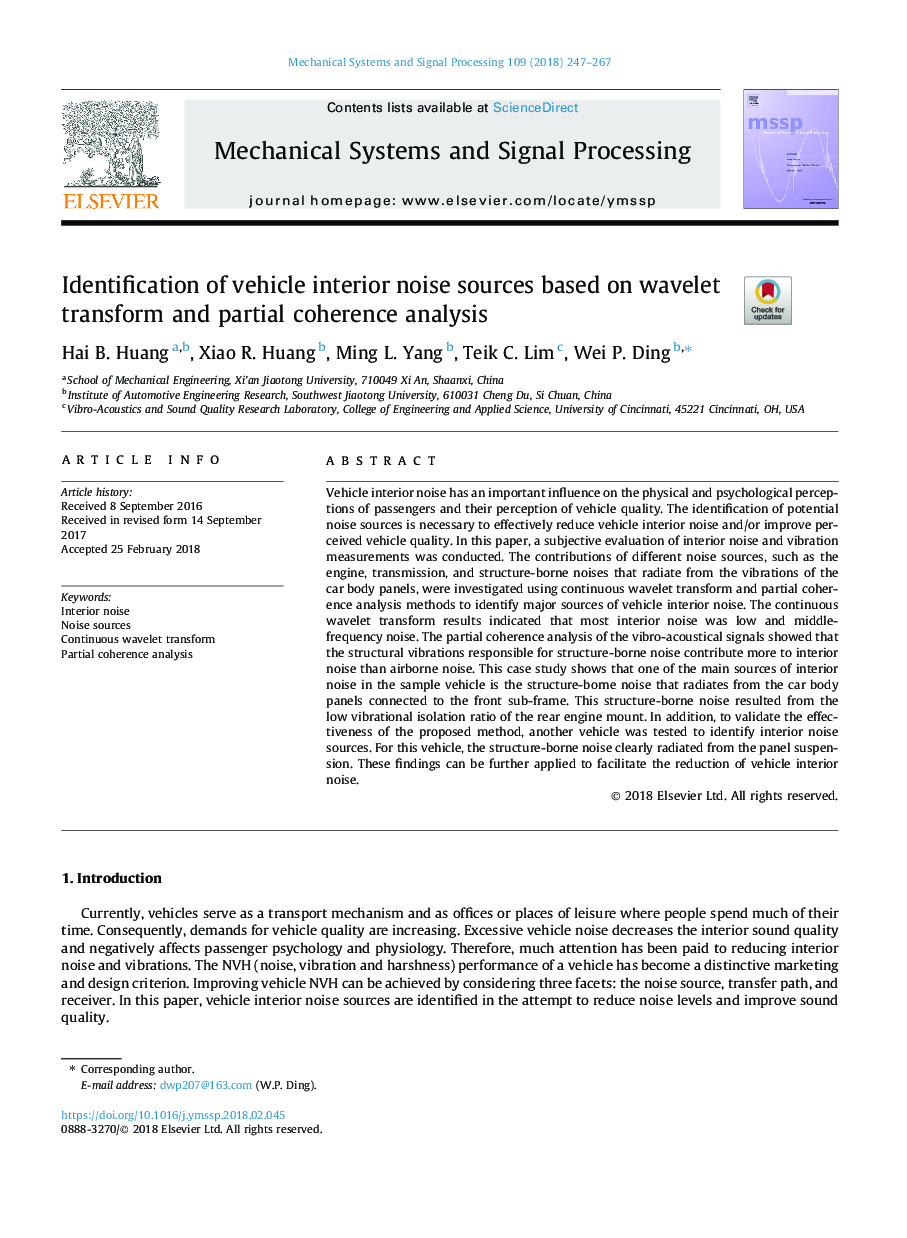| کد مقاله | کد نشریه | سال انتشار | مقاله انگلیسی | نسخه تمام متن |
|---|---|---|---|---|
| 6954114 | 1451826 | 2018 | 21 صفحه PDF | دانلود رایگان |
عنوان انگلیسی مقاله ISI
Identification of vehicle interior noise sources based on wavelet transform and partial coherence analysis
ترجمه فارسی عنوان
شناسایی منابع نویز داخلی خودرو بر مبنای تبدیل ویولت و تحلیل انسجام جزئی
دانلود مقاله + سفارش ترجمه
دانلود مقاله ISI انگلیسی
رایگان برای ایرانیان
کلمات کلیدی
سر و صدای داخلی، منابع صوتی، تبدیل موجک مداوم، تحلیل انسجام جزئی،
ترجمه چکیده
نویز داخلی خودرو تاثیر مهمی در درک فیزیکی و روان شناختی مسافران و درک آنها نسبت به کیفیت وسایل نقلیه دارد. شناسایی منابع صوتی بالقوه ضروری است تا به طور موثر کاهش سر و صدای داخلی خودرو و / یا بهبود کیفیت خودرو درک شود. در این مقاله، یک ارزیابی ذهنی از نویز داخلی و اندازه گیری ارتعاش انجام شد. سهم منابع مختلف نویز، مانند موتور، انتقال و نویز ساختاری که از ارتعاشات پانل های بدن خودرو منتشر می شود، با استفاده از تبدیل موجک تحریک و روش های تجزیه و تحلیل انسجام جزئی برای شناسایی منابع اصلی سر و صدایی داخلی خودرو مورد بررسی قرار گرفت. نتایج تغییر شکل موجک نشان داد که بیشتر صدا درون داخلی سر و صدا کم و متوسط بود. تجزیه و تحلیل جزئی انسجام سیگنال های ارتعاشی آکوستیک نشان می دهد که ارتعاشات ساختاری ناشی از نویز ساختار موجب افزایش نویز داخلی نسبت به نویز هوایی می شود. این مطالعه موردی نشان می دهد که یکی از منابع اصلی سر و صدای داخلی در خودرو نمونه، نویز ساختار است که از پانل های بدن خودرو متصل به زیر فریم جلو است. این نویز حاصل از ساختار به علت نسبت انحصاری ارتعاش کم موتور سوپاپ عقب ایجاد شده است. علاوه بر این، برای تأیید اثربخشی روش پیشنهادی، یک وسیله نقلیه دیگر برای شناسایی منابع سر و صدا داخلی مورد آزمایش قرار گرفت. برای این وسیله، نویز ساختار به وضوح از سوئیچ پانل منتشر شده است. این یافته ها را می توان برای تسهیل کاهش سر و صدایی داخلی خودرو اعمال کرد.
موضوعات مرتبط
مهندسی و علوم پایه
مهندسی کامپیوتر
پردازش سیگنال
چکیده انگلیسی
Vehicle interior noise has an important influence on the physical and psychological perceptions of passengers and their perception of vehicle quality. The identification of potential noise sources is necessary to effectively reduce vehicle interior noise and/or improve perceived vehicle quality. In this paper, a subjective evaluation of interior noise and vibration measurements was conducted. The contributions of different noise sources, such as the engine, transmission, and structure-borne noises that radiate from the vibrations of the car body panels, were investigated using continuous wavelet transform and partial coherence analysis methods to identify major sources of vehicle interior noise. The continuous wavelet transform results indicated that most interior noise was low and middle-frequency noise. The partial coherence analysis of the vibro-acoustical signals showed that the structural vibrations responsible for structure-borne noise contribute more to interior noise than airborne noise. This case study shows that one of the main sources of interior noise in the sample vehicle is the structure-borne noise that radiates from the car body panels connected to the front sub-frame. This structure-borne noise resulted from the low vibrational isolation ratio of the rear engine mount. In addition, to validate the effectiveness of the proposed method, another vehicle was tested to identify interior noise sources. For this vehicle, the structure-borne noise clearly radiated from the panel suspension. These findings can be further applied to facilitate the reduction of vehicle interior noise.
ناشر
Database: Elsevier - ScienceDirect (ساینس دایرکت)
Journal: Mechanical Systems and Signal Processing - Volume 109, 1 September 2018, Pages 247-267
Journal: Mechanical Systems and Signal Processing - Volume 109, 1 September 2018, Pages 247-267
نویسندگان
Hai B. Huang, Xiao R. Huang, Ming L. Yang, Teik C. Lim, Wei P. Ding,
